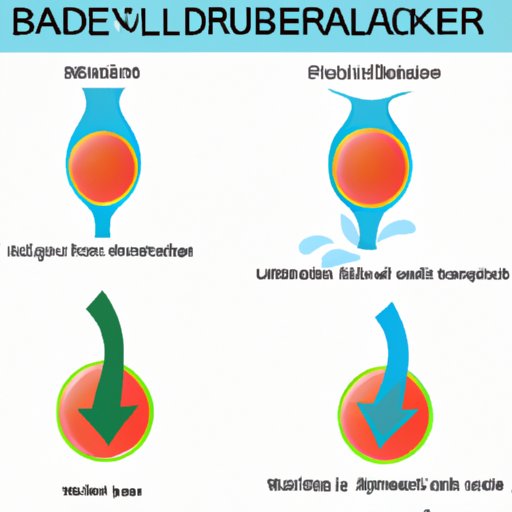
Introduction
Bladder leakage, also known as urinary incontinence, affects millions of people worldwide. It can have a significant impact on daily life, causing embarrassment, discomfort, and a decreased quality of life. In this article, we will explore the various treatment options for bladder leakage, including natural remedies, surgical procedures, and lifestyle changes. Our goal is to provide a comprehensive guide for those seeking relief from bladder leakage.
Navigating the Best Treatment Options for Bladder Leakage: A Comprehensive Guide
When it comes to treating bladder leakage, there are several options available. The best treatment plan will depend on various factors, including the type of bladder leakage, the severity of symptoms, and the individual’s overall health. Some treatment options may work better for certain people than others. Here is an in-depth look at some of the most common treatment options for bladder leakage:
Kegel Exercises
Kegel exercises are a type of pelvic floor exercise that involves contracting and relaxing the muscles that control urination. This exercise can help to strengthen the muscles that control the bladder, reducing the likelihood of leaks. Kegel exercises can be done discreetly and at any time, making them an excellent option for many people. It is essential to learn how to do Kegel exercises correctly, as performing them incorrectly can cause harm.
Medications
Several medications are available to treat bladder leakage, but they work differently for different people. Some medications can help to relax the bladder muscles, reducing bladder spasms and the urge to urinate. Other medications work by increasing the strength of the urethral sphincter, which can help to prevent leaks. It is essential to speak with a healthcare provider before starting any new medication, as some can have side effects and may not be suitable for everyone.
Pelvic Floor Physical Therapy
Pelvic floor physical therapy involves working with a trained physical therapist to strengthen the muscles of the pelvic floor. This therapy can help to improve bladder control, reduce leaks, and relieve symptoms. Pelvic floor physical therapy may involve exercises, biofeedback, or other techniques, depending on the individual’s needs.
Medical Devices
There are several medical devices available to treat bladder leakage, including urethral inserts, pessaries, and vaginal cones. These devices work by supporting the bladder and urethra, helping to prevent leaks. Medical devices can be an effective treatment option for some people, but they may not be suitable for everyone.
Natural Remedies for Managing Bladder Leakage
Many people find relief from bladder leakage through natural remedies, but it is essential to use caution when trying these remedies and consult with a healthcare provider before beginning any new treatment. Some natural remedies that can be effective for bladder leakage include:
Herbal Remedies
Several herbs can help to strengthen the bladder and reduce inflammation that contributes to bladder leakage. These herbs include cranberry, horsetail, and saw palmetto. Some people find relief by drinking these herbs as teas or taking them as supplements, but it is essential to speak with a healthcare provider before beginning any herbal treatment.
Acupuncture
Acupuncture involves the insertion of tiny needles into specific points on the body to help promote healing and balance. Some people find relief from bladder leakage by undergoing acupuncture treatments, but more research is needed to determine its effectiveness for treating bladder leakage.
Dietary Changes
Changing your diet can help to reduce inflammation, which can contribute to bladder leakage. Some dietary changes that can be helpful for bladder leakage include drinking plenty of water, avoiding caffeine and alcohol, and eating foods rich in fiber and nutrients.
Surgical Procedures for Bladder Leakage: What You Need to Know
For some people, surgical procedures may be necessary to treat bladder leakage. There are several surgical options available, including:
Urethral Bulking
Urethral bulking involves injecting a substance into the tissues surrounding the urethra to increase its size and help prevent leaks. This procedure is minimally invasive and can be done on an outpatient basis, but it may not be suitable for everyone.
Sling Procedures
A sling procedure involves placing a sling of tissue or synthetic material around the bladder neck and urethra to support them and prevent leaks. This procedure is typically done under general anesthesia and may require an overnight hospital stay.
Artificial Urinary Sphincter Implantation
An artificial urinary sphincter is a device that is implanted around the bladder neck and urethra to help control the flow of urine. This procedure is typically reserved for those with severe bladder leakage that does not respond to other treatments, and it requires a hospital stay and recovery time.
Living with Bladder Leakage: Coping Strategies and Lifestyle Changes
Although bladder leakage can be a challenging condition to live with, there are several coping strategies and lifestyle changes that can help to manage symptoms. Some strategies include:
Clothing and Supplies
Wearing certain types of clothing, such as dark colors or loose-fitting clothing, can help to conceal leaks. Carrying extra supplies, such as wipes, pads, or absorbent underwear, can also be helpful.
Timed Voiding
Timed voiding involves emptying the bladder on a regular schedule, regardless of the urge to urinate. This technique can help to manage symptoms and reduce the likelihood of leaks.
Healthy Habits
Eating a healthy diet, staying hydrated, getting enough exercise, and avoiding smoking can all help to reduce symptoms and improve overall health and wellbeing.
What Causes Bladder Leakage and Treatment Options?
Bladder leakage can have many causes, including weakened pelvic muscles, nerve damage, prostate problems, and certain medical conditions. Treatment options will depend on the underlying cause and the severity of symptoms. It is important to work with a healthcare provider to determine the best treatment plan for individual needs.
Conclusion
Bladder leakage can be a challenging condition to live with, but there are many treatment options available, ranging from natural remedies to surgical procedures. By working with a healthcare provider and exploring different treatments, it is possible to manage symptoms and improve quality of life.




